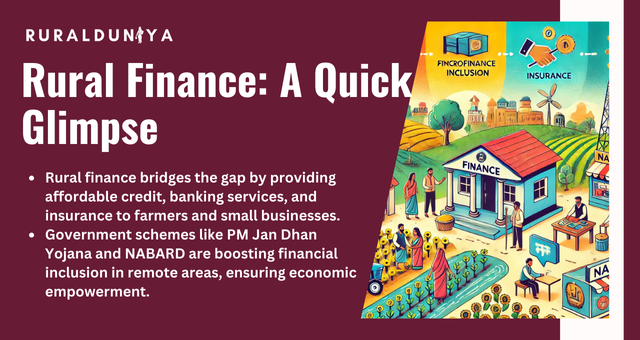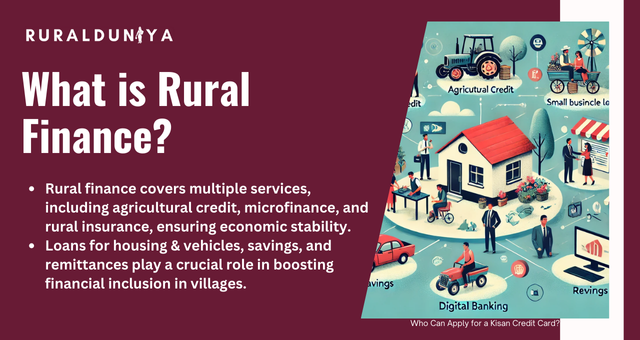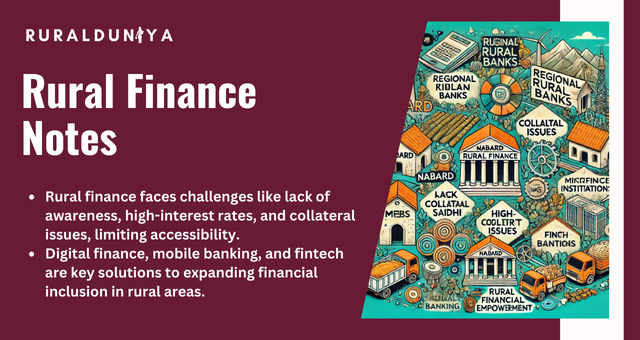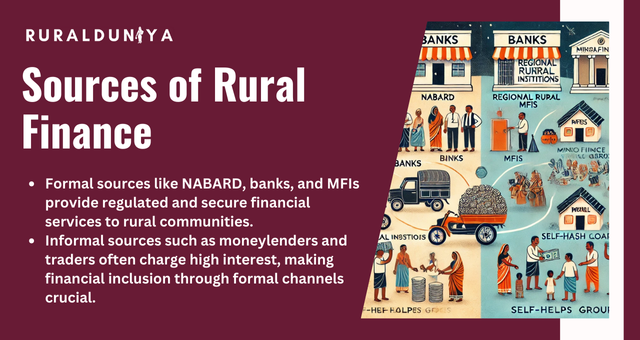Rural finance is the backbone of India’s agriculture-driven economy. It provides financial services to farmers, small businesses, and rural households, ensuring economic growth in villages.
From loans for seeds and fertilizers to funding small enterprises, it plays a crucial role in economic empowerment. 💡📈
Rural Finance: A Quick Glimpse

India’s rural population (65% of total) heavily depends on agriculture and small businesses. However, financial constraints often limit their growth. It bridges this gap by offering affordable credit, banking services, microfinance loans, and rural insurance to those who need it most. 🌾
The government, along with microfinance institutions (MFIs), banks, and cooperatives, is working tirelessly to expand financial inclusion. With schemes like PM Jan Dhan Yojana, NABARD initiatives, Kisan Credit Cards, and SHG-Bank Linkage Programs, financial access is improving in remote areas. 🚀
It isn’t just about loans—it includes savings, credit, insurance, and remittances, ensuring a robust economic ecosystem in villages. Let’s dive deeper! 📊
Rural Finance in India
India’s rural finance sector is evolving rapidly with new policies, digital banking, and microcredit initiatives. The National Bank for Agriculture and Rural Development (NABARD) is the key player, along with public sector banks, Regional Rural Banks (RRBs), and Self-Help Groups (SHGs). 💰
Some Key Facts & Figures 📊
- 65% of India’s population lives in rural areas 🌿
- 80% of rural households depend on agriculture 🚜
- Over 55% of farmers in India lack formal financial access 🚧
- NABARD disbursed ₹2.7 lakh crore in credit in 2022-23 📈
- Microfinance loans worth ₹2.9 lakh crore were distributed in 2023 💵
The numbers reflect the need for rural banking services, cooperative credit, and financial expansion to uplift rural livelihoods. 📊💡
What is Rural Finance?

It refers to financial services provided in rural areas, including: 🏦🔍
- Agricultural credit 🌱
- Microfinance for small businesses 🏪
- Rural insurance schemes 🛡️
- Loans for rural housing & vehicles 🚗🏡
- Savings and remittance services 💰
Characteristics of Rural Finance
1️⃣ Seasonal Demand: Loans are mostly needed during sowing & harvesting seasons 🌾
2️⃣ High Risk: Prone to weather fluctuations, price volatility, and crop failure ☔
3️⃣ Informal Borrowing: Many still rely on moneylenders charging high interest 😟
4️⃣ Government Intervention: Various schemes and subsidies are introduced to boost rural lending 📜
5️⃣ Long Loan Tenure: Agricultural loans typically have longer repayment periods 📅
Types of Rural Finance
It can be categorized into two major types:
1️⃣ Short-Term Finance 📆
- For seasonal agricultural activities 🌾
- Covers seeds, fertilizers, labor costs 🛠️
- Example: Kisan Credit Card (KCC)
2️⃣ Long-Term Finance 🏦
- For farm machinery, irrigation, and rural businesses 🚜
- Loan tenure 5 to 15 years 📅
- Example: NABARD Refinance Scheme
Rural Finance Notes

- Major Lenders: NABARD, RRBs, MFIs, Cooperative Banks 🏦
- Government Schemes: PM Kisan Samman Nidhi, PMEGP, SHG-Bank Linkage Program 📜
- Challenges: Lack of awareness, collateral issues, high-interest rates ❌
- Solutions: Digital finance, mobile banking, fintech in rural areas 📲
Rural Finance Companies in India
Several Non-Banking Financial Companies (NBFCs) and Microfinance Institutions (MFIs) play a critical role in rural credit.
Some major players include:
- Muthoot Microfin Ltd. 🏦
- SKS Microfinance 🌱
- Spandana Sphoorty 💵
- Bharat Financial Inclusion Ltd. 📊
- Mahindra Finance 🚜
Advantages of Rural Finance
🔹 Boosts Agricultural Productivity 🌾
🔹 Encourages Rural Entrepreneurship 💼
🔹 Reduces Dependence on Moneylenders ❌
🔹 Promotes Infrastructure Development 🏗️
🔹 Empowers Women & SHGs 👩💪
Sources of Rural Finance

📌 Formal Sources: NABARD, Banks, RRBs, MFIs, SHGs 📊
📌 Informal Sources: Moneylenders, Traders, Relatives 🤝
Rural Finance Expansion Programme
The government and private sector are working on expanding financial inclusion:
- Digital Banking & UPI in Rural Areas 📲
- Microfinance & Self-Help Group (SHG) Programs 💡
- Loan Waiver & Interest Subsidy Schemes 📜
- Mobile ATMs & Banking Correspondents 🏦
Conclusion
Rural finance is a lifeline for millions in India. While challenges exist, innovative solutions like digital banking, microfinance, and government schemes are making financial services more accessible. 🚀
For a self-reliant rural economy, expanding formal credit, promoting financial literacy, and leveraging fintech are the way forward. 💡💰
What do you think about it? Drop your thoughts in the comments below! 💬⬇️
FAQs
What is rural finance, and why is it important?
It provides financial services like loans, savings, and insurance to people in villages. It helps farmers, small businesses, and rural communities grow by giving them access to credit and banking facilities.
How can farmers get loans under rural finance schemes?
Farmers can apply for loans through banks, regional rural banks (RRBs), cooperative banks, and microfinance institutions (MFIs). Government schemes like Kisan Credit Card (KCC) and NABARD loans also help farmers get financial support.
What are the main challenges in rural finance?
Limited banking access, high-interest rates, lack of financial literacy, and dependence on informal lenders are common issues. However, digital banking and microfinance are helping to bridge this gap.
Which banks and institutions provide rural finance in India?
Key players include NABARD, State Banks, Regional Rural Banks (RRBs), Cooperative Banks, and NBFCs like Mahindra Finance and SKS Microfinance. These institutions ensure financial inclusion in rural areas.

Nishank is a social impact enthusiast with a solid foundation in public policy, micro-enterprise, and agribusiness. Growing up in a farmer’s family has given him a profound connection to rural communities, fueling his passion to empower people towards self-reliance. He completed his undergraduate studies at the Delhi University and earned a master’s degree in Rural Management from National Institute of Rural Development & Panchayati Raj in Hyderabad.



